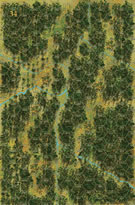|
Ioribaiwa Scenario 1: Ioribaiwa, Day One Kokoda Campaign #14 |
||
|---|---|---|
| (Defender) Australia | vs | Japan (Attacker) |
| Formations Involved | ||
|---|---|---|
| Australia |  |
21st Infantry Brigade |
| Japan |  |
41st Infantry Regiment |

|
| Overall Rating, 4 votes |
|---|
|
3.75
|
| Scenario Rank: --- of 940 |
| Parent Game | Kokoda Campaign |
|---|---|
| Historicity | Historical |
| Date | 1942-09-13 |
| Start Time | 14:00 |
| Turn Count | 10 |
| Visibility | Day |
| Counters | 33 |
| Net Morale | 0 |
| Net Initiative | 2 |
| Maps | 1: 34 |
| Layout Dimensions | 43 x 28 cm 17 x 11 in |
| Play Bounty | 143 |
| AAR Bounty | 165 |
| Total Plays | 4 |
| Total AARs | 2 |
| Battle Types |
|---|
| Ambush |
| Inflict Enemy Casualties |
| Road Control |
| Conditions |
|---|
| Hidden Units |
| Terrain Mods |
| Scenario Requirements & Playability | |
|---|---|
| Kokoda Campaign | Base Game |
| Introduction |
|---|
|
After several days of delaying attacks and ambushes by the tattered remnants of 21st Brigade against the advancing Japanese, the battle approached Ioribaiwa Ridge where Brigadier Eather had assembled all three battalions of 25th Brigade as well as the reserve 3rd Battalion from Maroubra Force. The Australians were set to counterattack on September 14th, but Maj. Gen. Horii acted first and ordered the depleted II Battalion of 41st Regiment to attack across the creek bottom. Unfortunately for him, the Japanese walked into an ambush manned by the remaining soldiers of the 2/14 and 2/16th Battalions. |
| Conclusion |
|---|
|
In the final battle of the long withdrawal from Efogi, the composite 2/14th and 2/16th Battalion held the creek crossing until nightfall, allowing Brigadier Eather to proceed with his planned counterattacks the next day. Meanwhile, Maj. Gen. Horii ordered all his remaining troops into a renewed offensive on the next day as well. |
| Ioribaiwa battle game scenario 1 | ||||||||||||||
|---|---|---|---|---|---|---|---|---|---|---|---|---|---|---|
From the Kokoda trail version, they have changed this : Japanese morale is 8/8 (instead of 9/8), no banzai charge, 10 turns long instead of 9, disorientation. With the Japanese, I chose to attack mainly in the center, following the trail (no disorientation along the trail) and flank movement on both aisles following the western and eastern creeks (no disorientation along the creeks). And, since time is short (10 turns only with all hexes made jungle and requiring 2 movement points...), I opted for Strategic movement too with engineers as recon troops. The western eng recon was killed right away by a hidden Australian MG + inf platoon (+2 for strategic mvt). The eastern recon left the eng stranded disoriented in the middle of nowhere (it never came back !) and the rest of the eastern flank was attacked by another hidden Australian MG + inf platoon. That fire only got a M result but I rolled 3 X box cars in reply = demoralized leader + demoralized unit. In the center, along the trail, it went better but I got stuck in an assault in the truly critical 1009 trail hex. Even if I went through that hex by reinforcing the assault and then leaving the hex with another unit, everything got bogged in these jungle hexes. Both sides firepower in assault is quite low so that you need luck in the first place... and it never came. We finished the scenario with a draw on the number of trail hexes controlled (5 for each and 2 contested) in a very tense and involved situation : a wild melee ! 5 Japanese casualties and 1 Australian. Australian Minor Victory. However, since we are playing the Ioribaiwa battle game, I just lose in this first scenario any chance of winning the battle game: I had to gain one trail hex more than the Australian ! Sigh. I will fight on for the draw now. |
||||||||||||||
| 0 Comments |
| Ioribaiwa Day 1 |
|---|
|
The Japanese forces dominated the initiative die roll, except for turn two, but struggled to mount any form of a good offense against the Australian forces, due to a combination of factors. Jungle Disorientation was a major one as well as the Aussie forces starting the game hidden but the most telling was the equal morale between the two forces, 8/8 which gave the Japanese one less column shift when in assault combat. The Aussies "bend but not break" defense allowed them to hold on to more of the trail hexes, 14, when compared to those that were controlled by the Japanese, 7. Aussies had good morale as well as a good pool of officers which gave them a spirited defense allowing them to win a minor victory when step losses were calculated to determine the victor of the scenario. |
| 0 Comments |

 KoCa013
KoCa013 














